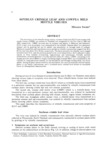Soybean Crinkle Leaf and Cowpea Mild Mottle Viruses
Tropical agriculture research series : proceedings of a symposium on tropical agriculture researches
| ISSN | 03889386 |
|---|---|
| 書誌レコードID(総合目録DB) | AA00870529 |

本文フルテキスト
tars19-_92-100.pdf1.88 MB
The occurrence of two whitefly-borne viruses, soybean crinkle leaf (SCLV) and cowpea mild mottle viruses (CMMV), on soybean in Thailand was recognized for the first time in 1983 and 1982, respectively. CMMV occurred also on soybean and peanut in Malaysia and Indonesia. SCLV, a new virus on soybean, was transmitted by the whitefly, Bemisia tabaci, in a persistent manner and by grafting but not by aphids, sap inoculation, or through seeds of soybean. Minimum acquisition and inoculation access periods in whitefly transmission ranged from 30 to 60 min and from about 10 to 30 min, respectively. The latent period in the whitefly vector ranged between 8 and 10 hr, and the retention period in the vector lasted 9 days. SCLV affected 11 plant species in three families (Compositae, Leguminosae, and Solanaceae). Partially purified preparations contained geminate virus-like particles (about18 x 30nm). CMMV, consisting of rod-shaped particles about 680nm in length containing single-stranded RNA, was transmitted by the whitefly in a semi-persistent manner, by·sap inoculation and through soybean seeds, but not by aphids. Among 26 plant species tested by sap inoculation, the virus systemically infected mainly plants of the family Leguminosae, and it produced poorly defined local lesions on inoculated leaves of Chenopodium amaranticolor.
| 刊行年月日 | |
|---|---|
| 作成者 | Mitsuro Iwaki |
| 公開者 | Japan International Research Center for Agricultural Sciences |
| 巻 | 19 |
| 開始ページ | 92 |
| 終了ページ | 100 |
| 言語 | eng |
